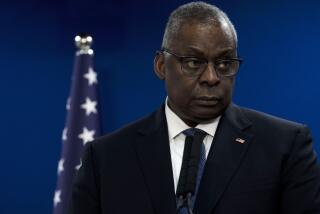U.S. Concedes Officer Took Military Photos : But Officials Assail Shooting by Soviets as ‘Totally Unjustified’
- Share via
WASHINGTON — The U.S. Army major killed by a Soviet sentry in East Germany was photographing Soviet military equipment inside a building in an area that had been off limits to Western military personnel as recently as Feb. 20, senior U.S. officials said Wednesday.
However, they insisted that the use of deadly force was “totally unjustified” in any case.
White House spokesman Larry Speakes said the State Department and National Security Council are considering “a number of diplomatic-related steps that we could take” to retaliate for the killing Sunday of Maj. Arthur D. Nicholson Jr. near the town of Ludwigslust. Speakes refused to be more specific.
Assistant Secretary of State Richard R. Burt, asked later at a House Foreign Affairs subcommittee hearing about possible retaliatory measures, said: “I would not want to comment in public on that. Our diplomatic discussions with the Soviet Union on the subject are continuing.”
Later in the afternoon, the State Department summoned Oleg Sokolov, the second-ranking diplomat in the Soviet Embassy, to a meeting with Burt. Sokolov declined comment as he entered the building.
The senior officials, representing the Pentagon and State Department, disputed some elements of the Soviet version of the shooting--which the State Department earlier called “tendentious”--but confirmed some others.
‘Camouflage Gear’
The Soviet version of the killing, distributed Tuesday by the Tass news agency, said Nicholson was dressed in “camouflage gear” when he penetrated a Soviet restricted area, opened the window of a military storage facility and took photographs of equipment inside.
The Soviets said that the incident was “tragic” but that the United States was responsible. Tass also said that the sentry fired warning shots and that Nicholson was slain as he tried to flee.
At the briefing Wednesday, the U.S. officials said Nicholson, 37, was in a standard U.S. camouflage uniform and was traveling in a clearly marked U.S. military vehicle. They confirmed that he was photographing military equipment--which other sources said were tanks--inside a building.
They also said they did not know if Nicholson had opened the window or found it open. But they contended that he was at least 300 yards away from the nearest restricted area, although he was slain in an area that had been under temporary restrictions until Feb. 20.
Bullet in Chest
The officials insisted that no warning shots were fired and that Nicholson was killed by a bullet that pierced his chest--a circumstance that would indicate he was not fleeing.
Even if everything in the Soviet version were true, one of the officials said, the Soviet sentry “had a right to detain (Nicholson)--he did not have a right to shoot him.”
Burt said of the Soviet version, “In some cases, it is distorted; in other cases it is deceptive, and in other cases, it is just flatly wrong.”
The senior U.S. officials, who briefed reporters on the understanding they would not be named, outlined the procedures that govern U.S., British, French and Soviet military liaison missions in Germany. They said they have never seen the standing orders given to Soviet sentries.
The missions were established in 1947 under an agreement among the four World War II victors, although many of the day-to-day rules apparently are based only on practice and precedent. U.S., British and French observers operate in East Germany and Soviet observers operate in West Germany.
Both Western and Soviet military observers regularly attempt to photograph military facilities while sentries try to prevent them from doing so, the officials contended. Each side is permitted to establish either permanent or temporary restricted areas that are closed to military observers.
The result is what one official called “a cat and mouse element” in which sentries on both sides sometimes arrest and detain observers. But in the 38 years the system has been in operation, no observer had been killed, the officials said. U.S. sentries, they said, are told that “no force should be used or lives endangered” when arrests are made.
More to Read
Sign up for Essential California
The most important California stories and recommendations in your inbox every morning.
You may occasionally receive promotional content from the Los Angeles Times.











